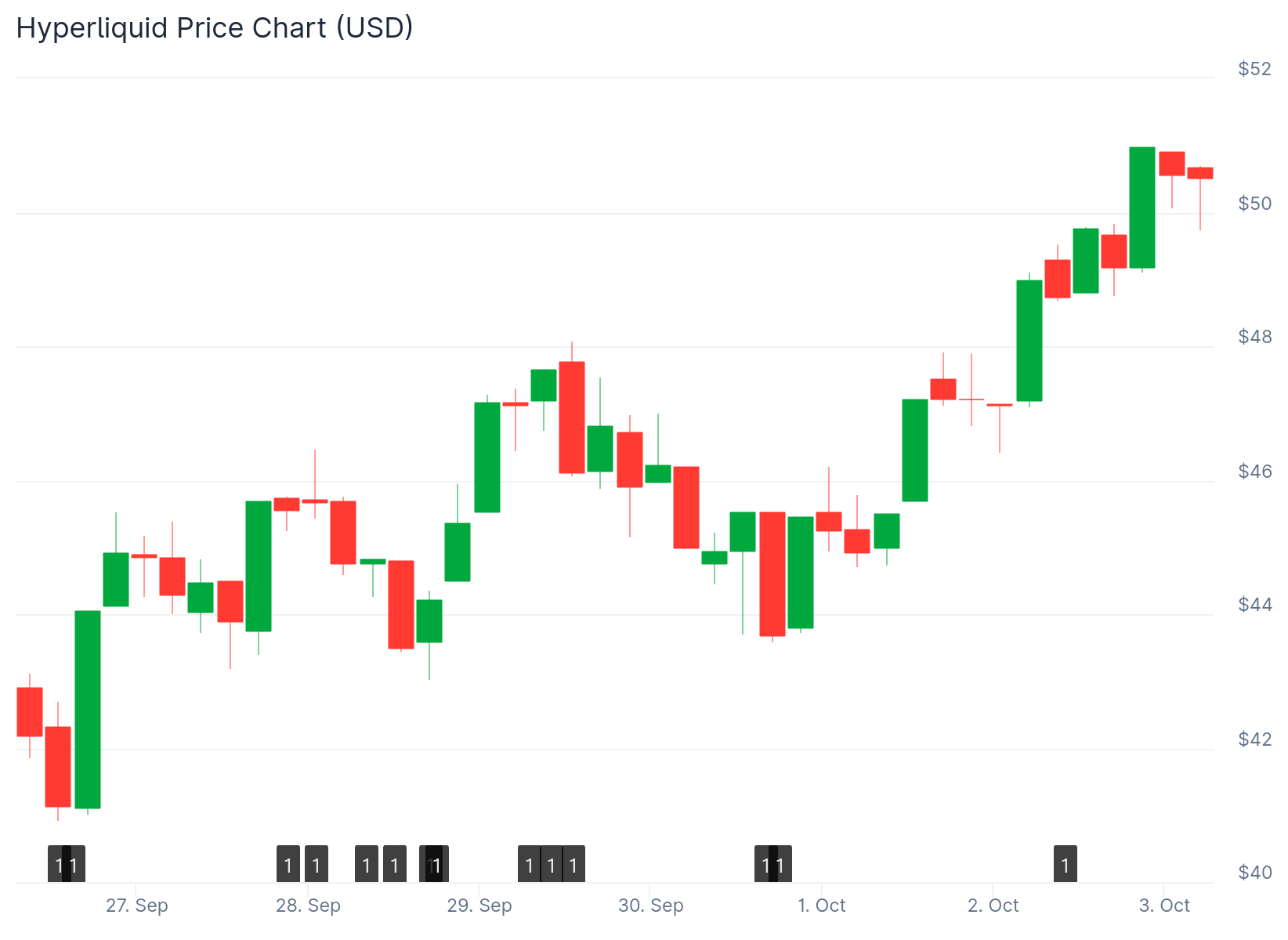TLDR
- Hyperliquid trades at $47.12 with $12.7 billion market cap and $540 million daily volume
- Platform generates $3 million in daily fees and controls 62% of perpetual DEX open interest
- Over 660,000 HYPE tokens staked through buyback programs reducing circulating supply
- Key support levels at $42 and $46 with potential breakout targets at $49 and $55-$60
- HyperEVM network hosts 100+ protocols with $2 billion total value locked
Hyperliquid is currently trading at $47.12, showing a gain of nearly 5% over the past 24 hours. The token maintains a market capitalization exceeding $12.7 billion with daily trading volume surpassing $540 million.

The price action has formed a pattern of higher lows following a recent correction. Traders are monitoring these support levels for signs of the next upward movement.
Community analysts have identified $60 as a fair value target for HYPE. The token has recovered ground without experiencing sharp volatility. Breaking through resistance in the mid-$50s with strong volume could bring the $60 level into range.
Fee Revenue Remains Strong Despite Competition
Hyperliquid generates approximately $3 million in daily fees. This revenue stream continues even as competitor Aster increases its market share. The steady fee income provides stability for the platform’s ecosystem.
Speculation exists that new platform features could increase daily fees beyond $10 million. Such developments would reshape the competitive dynamics among perpetual futures decentralized exchanges.
Technical indicators suggest the price structure remains healthy above $42 support. Moving averages are aligning favorably for bulls. The Relative Strength Index indicates room for additional upside movement.
Critical breakout levels sit between $44 and $49. Sustained closing prices in this range would create momentum toward higher valuations. A breakdown below $42 could trigger increased volatility.
Current consolidation is occurring above the $45 level with strong support at $46.10. Buyers have defended this zone through multiple tests. Holding this support creates potential for moves toward $48 to $49.
Staking Programs Tighten Token Supply
On-chain data reveals over 660,000 HYPE tokens are staked, representing approximately $30 million in value. Systematic buyback programs continue to grow these staking positions. This activity removes tokens from circulation and reinforces price stability.
The reduced available supply means each rally finds firmer support. When combined with daily fee generation, this creates positive feedback between fundamental metrics and technical performance.
Market Dynamics Shift Among Perpetual DEXes
DeFi analyst Patrick Scott published research stating Hyperliquid remains the strongest investment among perpetual DEXes. The platform’s volume market share dropped from 45% to 8% in recent weeks. During this period, Aster’s weekly trading volume expanded beyond $270 billion.
Scott’s analysis emphasizes that Hyperliquid’s fundamental metrics distinguish it from rivals. The platform produces consistent revenue while trading at reasonable valuation multiples. Open interest provides a more stable metric than trading volume alone.
Hyperliquid controls approximately 62% of open interest across perpetual DEXes. This measurement reflects deeper user engagement beyond temporary trading activity.
Platform Expansion Beyond Core Trading
The HyperEVM network currently supports over 100 protocols. This ecosystem has accumulated $2 billion in total value locked. These expansion efforts reduce reliance on perpetual futures trading as the sole revenue source.
USDH represents a new stablecoin initiative with reserves held through BlackRock and Superstate. The stablecoin launch adds another dimension to the platform’s offerings.
The HIP-3 proposal would enable developers to create new perpetual markets by staking substantial HYPE amounts. This mechanism would absorb circulating supply.
Scott’s analysis indicates his investment thesis would change if open interest or revenue declined substantially. He also noted USDH must achieve meaningful liquidity within the next year. Currently, he views Hyperliquid as better positioned than platforms relying heavily on token incentives.



